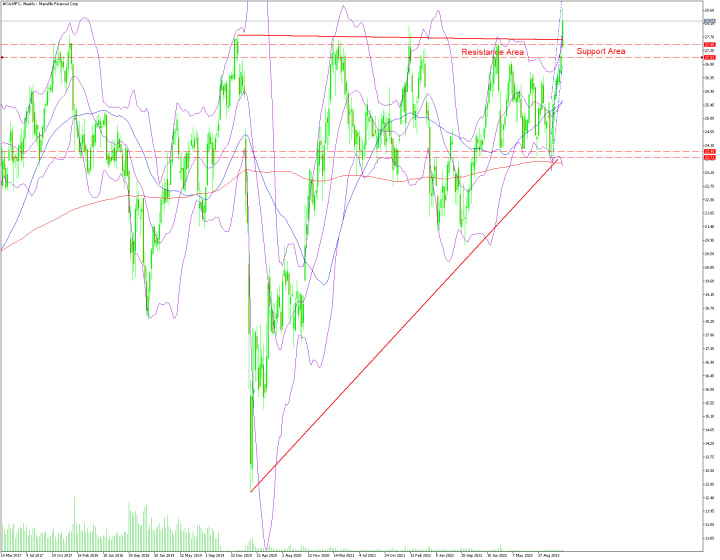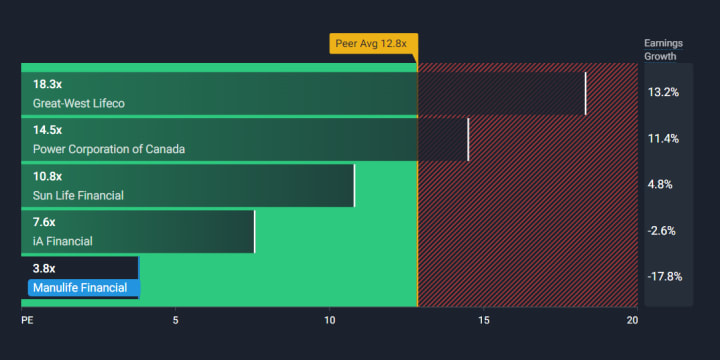Despite recent market volatility, Manulife Financial stock remains a stable option for income-seeking investors, so in this article we will dive into the chart patterns, indicators, and macro influences shaping MFC’s trajectory, offering insights for informed investment decisions. FreepikLet’s go Trend Analysis: Past, Present, and FutureThe last five years Manulife historical stock price have painted a dynamic picture. A steady climb from 2019 to 2020 was interrupted by the pandemic-induced crash, followed by a gradual recovery and a 2023 surge that saw the stock touch $28.26. Analyzing this movement through the lens of trendlines reveals:Trend Analysis: MFC exhibits a long-term slow upward trend (higher lows), punctuated by periods of consolidation and correction. The current trend, established in late 2022, has seen the stock climb steadily, recently breaching its 52-week high. This suggests potential for sustained growth, although it’s crucial to consider potential resistance levels.Ascending triangle: A long-term ascending triangle, defined by the highs around one resistance area, you can see on the chart below from 2019 to 2023, remains intact and we see higher lows throughout the last 5 years. This indicates a bullish formation, offering comfort for long-term holders.Bollinger Bands: The Bollinger Bands have widened recently, reflecting increased volatility. A break above the upper band could confirm the bullish trend.Moving averages: price is above both the 50-day and 200-day moving averages currently, which speaks of an uptrend trend upwards, also we have a golden cross pattern; it’s formed when the 50-day moving average crosses above the 200-day moving average.
FreepikLet’s go Trend Analysis: Past, Present, and FutureThe last five years Manulife historical stock price have painted a dynamic picture. A steady climb from 2019 to 2020 was interrupted by the pandemic-induced crash, followed by a gradual recovery and a 2023 surge that saw the stock touch $28.26. Analyzing this movement through the lens of trendlines reveals:Trend Analysis: MFC exhibits a long-term slow upward trend (higher lows), punctuated by periods of consolidation and correction. The current trend, established in late 2022, has seen the stock climb steadily, recently breaching its 52-week high. This suggests potential for sustained growth, although it’s crucial to consider potential resistance levels.Ascending triangle: A long-term ascending triangle, defined by the highs around one resistance area, you can see on the chart below from 2019 to 2023, remains intact and we see higher lows throughout the last 5 years. This indicates a bullish formation, offering comfort for long-term holders.Bollinger Bands: The Bollinger Bands have widened recently, reflecting increased volatility. A break above the upper band could confirm the bullish trend.Moving averages: price is above both the 50-day and 200-day moving averages currently, which speaks of an uptrend trend upwards, also we have a golden cross pattern; it’s formed when the 50-day moving average crosses above the 200-day moving average. Fundamental Forces: The Big PictureWhile technical analysis provides valuable insights, understanding the fundamental factors influencing MFC is crucial. Key considerations include:1. Interest rate environment:Rising rates: This can be beneficial for MFC in two ways:Increased investment income: Insurance companies invest a portion of their premiums, and higher interest rates mean greater returns on those investments. This boosts MFC’s profitability and potentially raises its valuation.Improved risk margins: In some insurance products, premiums are set based on expected future investment returns. Rising rates can allow MFC to adjust premiums for better risk management, leading to higher profits.Rapid hikes: While initially positive, rapid interest rate increases can also have negative consequences:Dampened economic activity: Higher borrowing costs can slow down economic growth, impacting demand for financial products like insurance and wealth management. This could lead to lower revenue for MFC.Reduced risk tolerance: Individuals and businesses may become more risk-averse in a high-interest environment, potentially opting for cheaper insurance options or delaying financial decisions. This could further decrease demand for MFC’s products. 2. Global economic climate:Strong economy: When the global economy is healthy, disposable incomes typically rise. This leads to increased demand for financial products like insurance, retirement plans, and wealth management, which benefits MFC.Economic slowdowns: During recessions or economic downturns, consumer spending and investment activity decline. This can significantly reduce demand for insurance and financial products, impacting MFC’s revenue and potentially leading to losses. 3. Regulatory landscape:Changes in regulations: The insurance industry is heavily regulated, and changes in those regulations can significantly impact MFC’s operations and profitability. For example, stricter capital requirements could increase operating costs, while new product restrictions could limit growth potential.Regulatory certainty: Stable and predictable regulatory environments provide clarity for businesses to operate and plan for the future. This can benefit MFC by fostering investor confidence and promoting long-term growth.Understanding these fundamental factors is crucial for making informed decisions about MFC’s value and future prospects. By considering the interplay of interest rates, global economic conditions, and the regulatory environment, investors and analysts can gain valuable insights into the company’s potential performance.Predicting the Unpredictable: Long-Term ForecastsForecasting the future is a fool’s errand, as you know, but based on the analyzed data, some potential scenarios for MFC emerge:Bullish outlook: Continued economic strength, rising interest rates, and successful execution of growth strategies could propel MFC towards the upper channel trendline, potentially reaching $33.80 within the next year, as suggested by some analysts’ forecasts.Neutral outlook: A stagnant economic environment or volatile interest rates could lead to sideways movement within the channel, presenting potential entry points during dips and exit points during peaks.And Bearish outlook: An unexpected economic downturn or adverse regulatory changes could trigger a break below the lower channel line, necessitating a reassessment of the investment thesis. (low possibility) Trading Strategies You Can Put Into PracticeStrategies you could consider:Trend following: Leverage the uptrend by buying on pullbacks towards the moving averages or support levels within the channel. You can see on a 4-hour chart that we have a nice uptrend channel
Fundamental Forces: The Big PictureWhile technical analysis provides valuable insights, understanding the fundamental factors influencing MFC is crucial. Key considerations include:1. Interest rate environment:Rising rates: This can be beneficial for MFC in two ways:Increased investment income: Insurance companies invest a portion of their premiums, and higher interest rates mean greater returns on those investments. This boosts MFC’s profitability and potentially raises its valuation.Improved risk margins: In some insurance products, premiums are set based on expected future investment returns. Rising rates can allow MFC to adjust premiums for better risk management, leading to higher profits.Rapid hikes: While initially positive, rapid interest rate increases can also have negative consequences:Dampened economic activity: Higher borrowing costs can slow down economic growth, impacting demand for financial products like insurance and wealth management. This could lead to lower revenue for MFC.Reduced risk tolerance: Individuals and businesses may become more risk-averse in a high-interest environment, potentially opting for cheaper insurance options or delaying financial decisions. This could further decrease demand for MFC’s products. 2. Global economic climate:Strong economy: When the global economy is healthy, disposable incomes typically rise. This leads to increased demand for financial products like insurance, retirement plans, and wealth management, which benefits MFC.Economic slowdowns: During recessions or economic downturns, consumer spending and investment activity decline. This can significantly reduce demand for insurance and financial products, impacting MFC’s revenue and potentially leading to losses. 3. Regulatory landscape:Changes in regulations: The insurance industry is heavily regulated, and changes in those regulations can significantly impact MFC’s operations and profitability. For example, stricter capital requirements could increase operating costs, while new product restrictions could limit growth potential.Regulatory certainty: Stable and predictable regulatory environments provide clarity for businesses to operate and plan for the future. This can benefit MFC by fostering investor confidence and promoting long-term growth.Understanding these fundamental factors is crucial for making informed decisions about MFC’s value and future prospects. By considering the interplay of interest rates, global economic conditions, and the regulatory environment, investors and analysts can gain valuable insights into the company’s potential performance.Predicting the Unpredictable: Long-Term ForecastsForecasting the future is a fool’s errand, as you know, but based on the analyzed data, some potential scenarios for MFC emerge:Bullish outlook: Continued economic strength, rising interest rates, and successful execution of growth strategies could propel MFC towards the upper channel trendline, potentially reaching $33.80 within the next year, as suggested by some analysts’ forecasts.Neutral outlook: A stagnant economic environment or volatile interest rates could lead to sideways movement within the channel, presenting potential entry points during dips and exit points during peaks.And Bearish outlook: An unexpected economic downturn or adverse regulatory changes could trigger a break below the lower channel line, necessitating a reassessment of the investment thesis. (low possibility) Trading Strategies You Can Put Into PracticeStrategies you could consider:Trend following: Leverage the uptrend by buying on pullbacks towards the moving averages or support levels within the channel. You can see on a 4-hour chart that we have a nice uptrend channel Momentum trading: Ride the wave of positive momentum using MACD signals or Bollinger Band breakouts for quick entries and exits.
Momentum trading: Ride the wave of positive momentum using MACD signals or Bollinger Band breakouts for quick entries and exits. Value investing: Focus on fundamental factors and identify entry points during periods of undervaluation based on price-to-earnings. MFC’s PE Ratio for today is 3.87, let’s check out MFC’s PE Ratio compared to its peers and E Ratio compare vs other companies in the North American Insurance Industry and see where they stand.
Value investing: Focus on fundamental factors and identify entry points during periods of undervaluation based on price-to-earnings. MFC’s PE Ratio for today is 3.87, let’s check out MFC’s PE Ratio compared to its peers and E Ratio compare vs other companies in the North American Insurance Industry and see where they stand. and
and Note: A low P/E ratio is a sign of undervaluation, a high P/E ratio is a sign of overvaluation Bottom LineManulife Financial is a good case for long-term investors seeking a blend of value and potential growth. The technical analysis reveals a bullish trend with supportive indicators, while the fundamental factors paint a picture of a company well-positioned to benefit from rising interest rates and a strong global economy.However, like any investment, Manulife comes with its own set of risks, with economic slowdowns and regulatory changes posing potential challenges. Key Takeaways
Note: A low P/E ratio is a sign of undervaluation, a high P/E ratio is a sign of overvaluation Bottom LineManulife Financial is a good case for long-term investors seeking a blend of value and potential growth. The technical analysis reveals a bullish trend with supportive indicators, while the fundamental factors paint a picture of a company well-positioned to benefit from rising interest rates and a strong global economy.However, like any investment, Manulife comes with its own set of risks, with economic slowdowns and regulatory changes posing potential challenges. Key Takeaways
Remember, the future is never certain, and even the most thorough analysis cannot guarantee success.Good Luck!More By This Author:American Airlines Group: Potential Opportunities And Challenges
How To Trade Moving Averages
Energy Stocks Face Headwinds In 2024: Analysts Predict Price Downturn












Leave A Comment